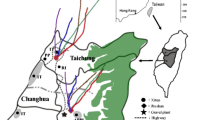Abstract
Particles with aerodynamic diameters <10 \(\upmu \)m (PM10) and particles with aerodynamic diameters <2.5 \(\upmu \)m (PM2.5) were sampled during summer 2006 in Beijing and mass concentrations, water-soluble ionic compounds concentrations, and acidic buffer capacity were analyzed. Results show that the mass concentration ranges of PM10 and PM2.5 were from 56.4 to 226.6 \(\upmu \)g/m3 and from 31.3 to 200.7 \(\upmu \)g/m3 during sampling days, respectively. Concentrations of F − , Cl − , NO\(_{3}^{\,\,-}\), NO\(_{2}^{\,\,-}\), SO\(_{4}^{\,\,2-}\), Ac − , Ca2 + , Na + , K + , Mg2 + , and NH\(_{4}^{\,\,+}\) in particles were analyzed by ion chromatography. Microtitration was adapted to determine the acidic–basic property and the change of the buffering systems in different pH of the aqueous solution in which the PM is suspended. The major alkalinity and buffer capacity of particles were analyzed and calculated. The average carbonate buffer capacity was 0.3 mmol/g in PM2.5 and 0.7 mmol/g in PM10. The average acetic acid buffer capacity was 0.1 mmol/g in PM2.5 and 0.3 mmol/g in PM10. Carbonate and acetic acid are the main species for the buffer capacity in the particle phase. The average mass of carbonate was 71.0 mg/g in PM10 and 46.7 mg/g in PM2.5. The average mass of acetic acid was 11.2 mg/g in PM2.5 and 20.0 mg/g in PM10.
Similar content being viewed by others
References
Larssen, T., & Carmichael, G. R. (2000). Acid rain and acidification in China: The importance of base cation deposition. Environmental Pollution, 110(1), 89–102.
Larssen, T., Seip, H. M., Semb, A., Mulderc, J., Munizd, I. P., Vogta, R. D., et al. (1999). Acid deposition and its effects in China: An overview. Environmental Science & Policy, 2(1), 9–24.
Larssen, T., Lydersen, E., Tang, D. G., He, Y., Gao, J. X., Liu, H. Y., et al. (2006). Acid rain in China. Environmental Science and Technology, 40(2), 418–425.
Sha, Y., Wang, A. P., Yang, S. L., & Liu, P. S. (1996). Correlation of acid rain with the distributions of acid and alkaline elements in aerosols. Nuclear Instruments and Methods in Physics Research B, 109/110, 551–554.
Tang, A. H., Zhuang, G. S., Wang, Y., Yuan, H., & Sun, Y. L. (2005). The chemistry of precipitation and its relation to aerosol in Beijing. Atmospheric Environment, 39(19), 3397–3406.
Wang, W. X. (1994). Study of the origin of acid rain formation in China. China Environmental Science, 14(5), 323–329.
Wang, W. X., & Wang, T. (1996). Short communication on acid rain formation in China. Atmospheric Environment, 30(23), 4091–4093.
Wang, W., Wang, W. X., Chen, Z. L., & Quan, H. (1996). Acidity of winter SPM in Kando of Japan and its contribution for acid rain formation. China Environmental Science, 16(6), 438–442.
Wang, W., Wang, Y., Su, H. M., Pan, Z., Yue, X., Liu, H. J., et al. (2001). Acidity and acid buffering capacity of aerosols during sand-dust storm weather in Beijing. Environmental Science, 22(5), 25–28.
Xiao, H. Y., & Liu, C. Q. (2004). Chemical characteristics of water-soluble components in TSP over Guiyang, SW China, 2003. Atmospheric Environment, 38(37), 6297–6306.
Xu, X. H., Yao, R. K., & Li, J. L. (1996). Acid and base characteristics of ambient aerosols in Qingdao area. Research of Environmental Sciences, 9(5), 5–8.
Yukio, S., Keiji, U., Sakingo, I., Kozaburo, H., Suzuki, Y., Imai, S., et al. (1997). A field study of the incorporation of atmospheric species into raindrops. Atmospheric Environment, 31(9), 1369–1379.
Zeng, F. G., Wang, W., Yang, Z. F., Pan, Z., & Yin, L. H. (2001). Study and analysis of acidifying buffer capacity of aerosols. Environmental Monitoring in China, 17(4), 13–17.
Zheng, W. X., Sun, Q. R., Zhang, W. B., & Zhou, F. M. (1998). Alkaline component of atmospheric particulate matter in Beijing. Climatic and Environmental Research, 3(1), 89–95.
Zhou, G. P., & Tazaki, K. (1996). Seasonal variation of gypsum in aerosol and its effect on the acidity of wet precipitation on the Japan Sea side of Japan. Atmospheric Environment, 30(19), 3301–3308.
Author information
Authors and Affiliations
Corresponding author
Rights and permissions
About this article
Cite this article
Huo, M., Sun, Q., Bai, Y. et al. Acidic and basic properties and buffer capacity of airborne particulate matter in an urban area of Beijing. Environ Monit Assess 176, 355–364 (2011). https://doi.org/10.1007/s10661-010-1588-z
Received:
Accepted:
Published:
Issue Date:
DOI: https://doi.org/10.1007/s10661-010-1588-z




